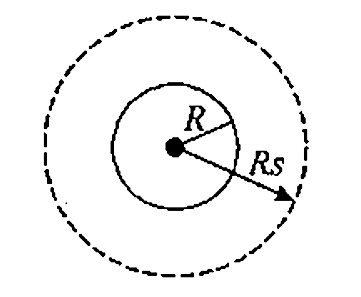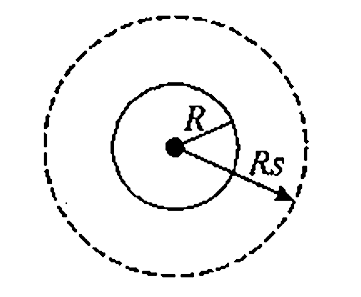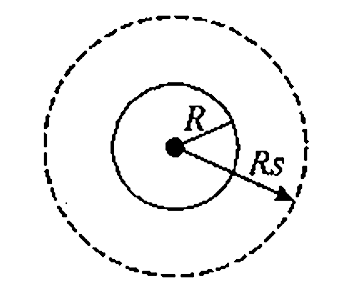Supernova refer to the explosion of a massive star. The material in the central case of such a star continues to collapse under its own gravitational pull. If mass of the core is less is than 1.4 times the mass of sun, its collapse finally results in a white dwarf star. However, if the core has a mass greater than this, it could end up soon as a neutron. star and if its mass is more than about three solar masses, the collapse may still continue till the star becomes a very small object with an extremely high value of density called a 'Black hole'. Escape speed for a black hole is very large. The figure shows a block hole of radius R and another concentric sphere of radius RS, called the 'Schwarzschild Radius'. It is the critical radius at which escape speed equals the speed of light c. Nothing even the light, can escape from within the sphere of Radius RS. So light from a black hole can not escape and hence the terminology 'black hole'. There has been astronomical evidence of a small and massive object at the centre of our galaxy the 'Milky way'. Suppose that there is a particle at a distance about 6 light years. that orbits this massive object with an orbital speed of about 2×105m/s. Use the given data whereever necessary and answer the questions that hollow. G=6.67×10−11N−m2/kg2, Solar mass M=2×1030kg,C=3×108m/s,1 light year =9.5×1015m.

Theories suggest that it is not possible for a single star to have a mass of more than 50 masses. The massive object at the centre of milky way galaxy is most likely to be a :
white dwarf
neutron star
black hole
single ordinary star
The correct Answer is:C
Topper's Solved these Questions
- GRAVITATIONBOOK - PHYSICS GALAXY - ASHISH ARORACHAPTER - GRAVITATIONEXERCISE - Advance MCQs
17 Videos
- GRAVITATIONBOOK - PHYSICS GALAXY - ASHISH ARORACHAPTER - GRAVITATIONEXERCISE - Unsolved Numerical
94 Videos
- GRAVITATIONBOOK - PHYSICS GALAXY - ASHISH ARORACHAPTER - GRAVITATIONEXERCISE - Concetual MCQ
39 Videos
- FLUID MECHANICSBOOK - PHYSICS GALAXY - ASHISH ARORACHAPTER - FLUID MECHANICSEXERCISE - Unsolved Numerical Problems
86 Videos
- KINEMATICSBOOK - PHYSICS GALAXY - ASHISH ARORACHAPTER - KINEMATICSEXERCISE - Unsolved Numerical Pro.
83 Videos
Similar Questions
Two objects of masses m and 4m are at rest at an infinite separation. They move towards each other under mutual gravitational attraction. If G is the universal gravitaitonal constant, then at separation r
View SolutionAt what distance from the center of the earth will a 1 kg object have a weight of 1N ? If released from rest at this distance, What will its initial acceleration be ?
View SolutionIf the gravitational force were potential to 1r, then a particle in a circular orbit under such a force would have its original speed:
View SolutionA block of wood floats in water two-thirds of its volume submerged. In oil the block of floats with 0.90 of its volume submerged. Find the density of (a) wood and (b) oil, if density of water I 103kg/m3.
View SolutionA ball is released from rest. If it takes 1 second to cross the last 20 m before hitting the ground, find the height from which it was dropped.
View SolutionWhy spin angular velocity of a star is greatly enhanced when it collapses under gravitational pull and becomes a neutron star ?
View SolutionIf a spherically symmetric star of radius R collapsed under its own weight, neglecting any forces other than gravitational ones, what is the time required for collapse?
View SolutionA massive star is spinning about its diameter with an angular speed omega_(0) = (pi)/(1000) rad/day. After its fuel is exhausted, the star collapses under its own gravity to form a neutron star. Assume that the volume of the star decreases to 10^(-12) times the original volume and its shape remains spherical. Assuming that density of the star is uniform, find the angular speed of the neutron star.
View SolutionIn a binary star system one of the stars has mass equal to mass of sun (M) . Separation between the stars is four times the average separation between earth and sun. Mass of the other star so that time period of revolution of the stars each other is equal to one earth year is
View SolutionA rotating star has a period of 30 days about an axis passing through its centre. The star undergoes an internal explosion and converts to a neutron star. Initial radius of the core was 1.0xx10^(4) km, whereas, final radius is 3.0km . Determine the period of rotation of the neutron star.
View SolutionConsider a white dwarf and a nutron star beach of one solar mass. The radius of the white dwarf is same as that of the eartyh (=6400km) and the radius of the neutron star is 10 km. Determine the densities of the two types of the stars. Take mass of the sun =2.0xx10^(30) kg.
View SolutionSupernova refer to the explosion of a massive star. The material in the central case of such a star continues to collapse under its own gravitational pull. If mass of the core is less is than 1.4 times the mass of sun, its collapse finally results in a white dwarf star. However, if the core has a mass greater than this, it could end up soon as a neutron. star and if its mass is more than about three solar masses, the collapse may still continue till the star becomes a very small object with an extremely high value of density called a 'Black hole'. Escape speed for a black hole is very large. The figure shows a block hole of radius R and another concentric sphere of radius RS, called the 'Schwarzschild Radius'. It is the critical radius at which escape speed equals the speed of light c. Nothing even the light, can escape from within the sphere of Radius RS. So light from a black hole can not escape and hence the terminology 'black hole'. There has been astronomical evidence of a small and massive object at the centre of our galaxy the 'Milky way'. Suppose that there is a particle at a distance about 6 light years. that orbits this massive object with an orbital speed of about 2×105m/s. Use the given data whereever necessary and answer the questions that hollow. G=6.67×10−11N−m2/kg2, Solar mass M=2×1030kg,C=3×108m/s,1 light year =9.5×1015m.

Mass (in kg) of the massive object at the centre of the milky galaxy is of the order :
View SolutionSupernova refer to the explosion of a massive star. The material in the central case of such a star continues to collapse under its own gravitational pull. If mass of the core is less is than 1.4 times the mass of sun, its collapse finally results in a white dwarf star. However, if the core has a mass greater than this, it could end up soon as a neutron. star and if its mass is more than about three solar masses, the collapse may still continue till the star becomes a very small object with an extremely high value of density called a 'Black hole'. Escape speed for a black hole is very large. The figure shows a block hole of radius R and another concentric sphere of radius RS, called the 'Schwarzschild Radius'. It is the critical radius at which escape speed equals the speed of light c. Nothing even the light, can escape from within the sphere of Radius RS. So light from a black hole can not escape and hence the terminology 'black hole'. There has been astronomical evidence of a small and massive object at the centre of our galaxy the 'Milky way'. Suppose that there is a particle at a distance about 6 light years. that orbits this massive object with an orbital speed of about 2×105m/s. Use the given data whereever necessary and answer the questions that hollow. G=6.67×10−11N−m2/kg2, Solar mass M=2×1030kg,C=3×108m/s,1 light year =9.5×1015m.

If mass of earth ME≈6×1024kg and its radius RE=6400km, to what fraction of its presents radius does the earth need to be compressed in order to become a black hole ?
(Give only the order of your answer)
View SolutionA star of mass M (equal to the solar mass) with a planet (much smaller than the star) revolves around the star in a circular orbit. The velocity of the star with respect to the center of mass of the star-planet system is shown below :
View SolutionDensity of a neutron star is 2.7xx10^(17)kg m^(-3) . Assume the star to be spherical, calculate the radius of the neutron star if its mass is twice the mass of the sun. Take mass of the sun =2.0xx10^(30)kg
View Solution
